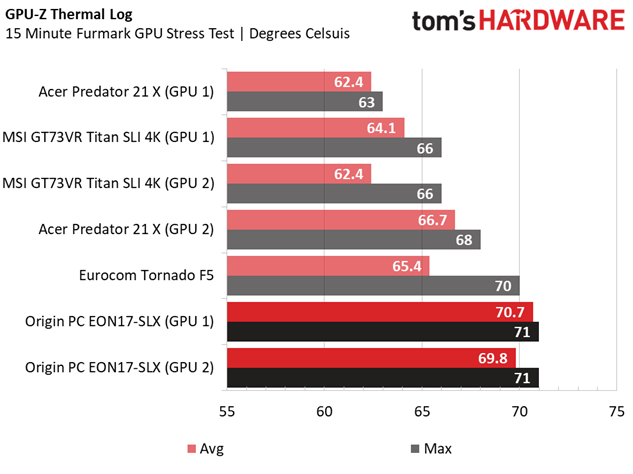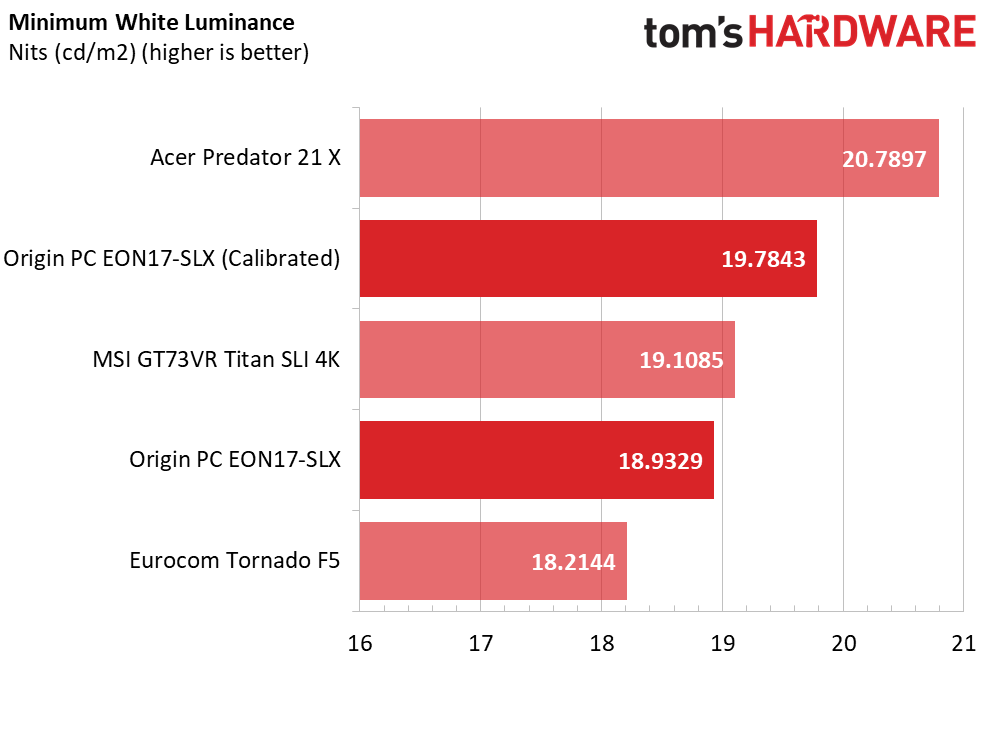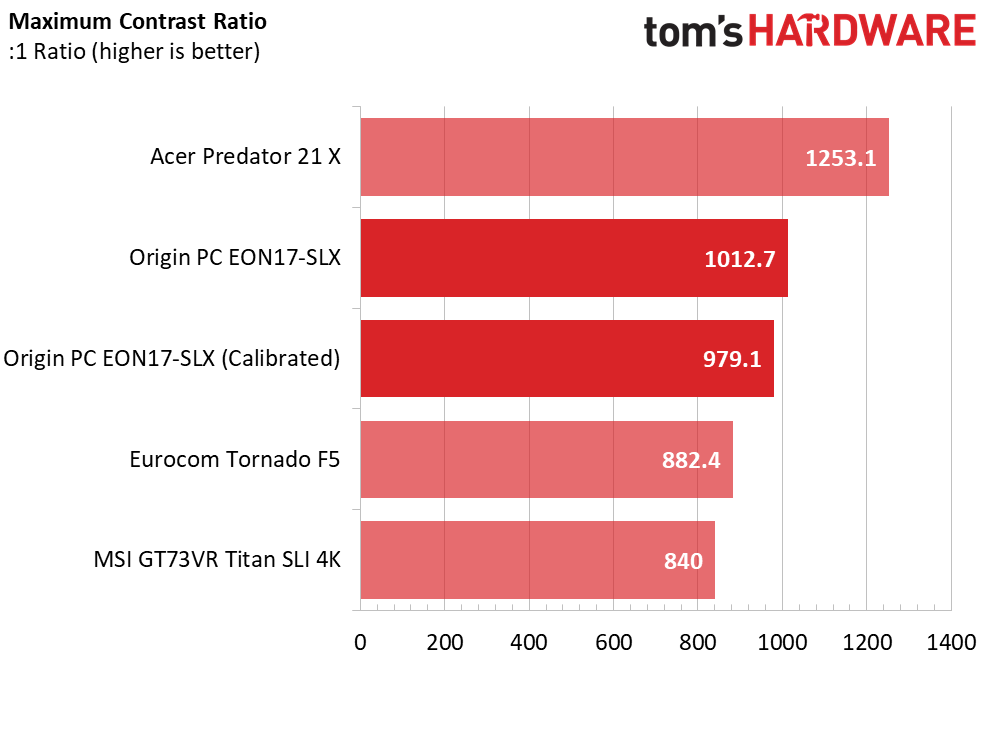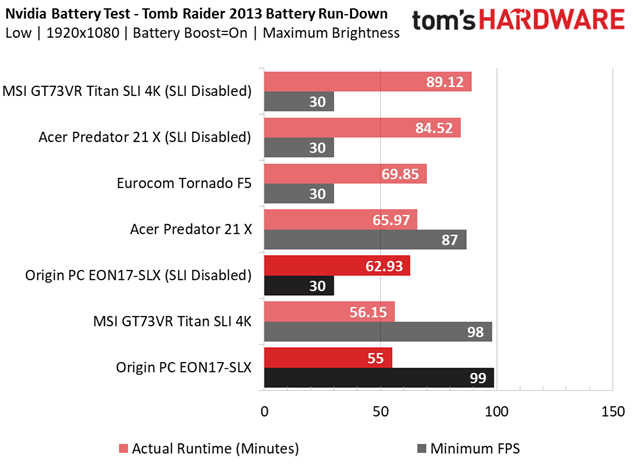Origin PC EON17-SLX Gaming Laptop Review
Why you can trust Tom's Hardware
Battery, Thermal & Display Testing
Battery Test - Tomb Raider 2013 Battery Rundown
To test battery life, we set each laptop’s battery profile to Balanced while running Tomb Raider’s built-in benchmark at the lowest detail preset. The frame rate is locked at 30 FPS through GeForce Experience’s Battery Boost to limit the strain on the battery. Meanwhile, a script running in the background monitors and time stamps the system’s battery percentage. The laptops are set to hibernate once battery levels reach 5%. We test the battery life at 200 nits.
Gaming laptops typically don’t exhibit great battery life, even during normal usage. Rendering a game continuously will impact that greatly. Add a desktop-class processor and an additional graphics card to the mix and you'll suffer even worse battery time. The Origin PC EON17-SLX checks all of the expected boxes, and it falls to last place. With SLI enabled, the EON17-SLX doesn’t even last an hour, and disabling one GTX 1080 hardly improves it.
Comparatively, the Eurocom Tornado F5 lasts a bit longer, delivering a meager additional seven minutes of play time.
Thermal Testing
We use our Optris PI 640 infrared camera to measure the laptop’s thermals. To compliment our thermal images, we take the average and maximum temperature from GPU-Z’s thermal log. For more information about how we test, be sure to check out our Measurement Science article.



The EON17-SLX starts off cool at idle, with GPU temperatures hovering around 41° C. The temperatures shoot up immediately when Furmark is launched, but the temperatures consistently hover around the 70° mark, maxing out at 71° C. The Origin’s GTX 1080s run the hottest out of the bunch, but 70° C is well within safe operating temperatures; cooling two power-hungry GPUs is not easy.
Display Testing
[Editor's Note: We have updated this page on 8/29/2017 to include additional results derived from using Origin's calibration profile.]
We used the SpectraCal C6 Colorimeter to measure the Origin PC EON17-SLX's display. Our configuration of the EON17-SLX comes with a calibration profile, so we tested the display with and without calibration. Be sure to check out our Display Testing Explained article for a full description of our test methodology.
Get Tom's Hardware's best news and in-depth reviews, straight to your inbox.






The EON17-SLX’s display has solid contrast levels. Its minimum and maximum white luminances aren’t outstanding, but it exhibits low minimum and maximum black luminances. Before calibration, the EON17-SLX display has slightly higher contrasts, and maintains a higher contrast ratio than the Tornado F5 and Titan SLI with and without its calibration profile. The Origin only loses out to the Predator 21 X, which has one of the best laptop displays we’ve tested.










Without the calibration profile, the RGB levels start off balanced, but lose that balance almost immediately after brightness increases. Red levels rise while blue and green levels fall, creating a noticeably red tint. The calibration profile doesn't improve matters much; red levels are still quite prominent and blue levels still fall considerably. However, green levels remain much more balanced.
A DeltaE 2000 of 3 is optimal, and anything below that is indistinguishable. Before calibration, the EON17-SLX’s grayscale is quite inaccurate; applying the calibration profile improves the grayscale accuracy quite a bit, but the Origin PC's display still remains the most inaccurate out of the four laptops grayscale-wise.



A gamma point of 2.2 is optimal for balanced saturation. Calibration raises the gamma point from 2.2506 to 2.2976. The uncalibrated gamma point chart is rather flat, but rises between 20% and 50% and once again at 90%; at these points, the display exhibits slight oversaturation. The calibrated gamma point chart is mostly the same, but slightly raised, which translates to a bit more saturation.
Like our grayscale measurements, overall color accuracy is measured by DeltaE 2000, with values of 3 and below being imperceptible. Unfortunately, the EON17-SLX's display has the lowest color accuracy out of the displays tested, and the calibration profile provides a detrimental effect. Almost all colors—reds, greens, cyans, and magentas—are misrepresented. It appears that the calibration profile doesn't help matters. The grayscale accuracy is improved, but at the expense of contrasts, gamma, and color accuracy.
MORE: Best Gaming Laptops
MORE: Gaming Laptop Previews
MORE: All Laptop Content
Current page: Battery, Thermal & Display Testing
Prev Page Gaming Benchmarks Next Page Price Analysis & Conclusion